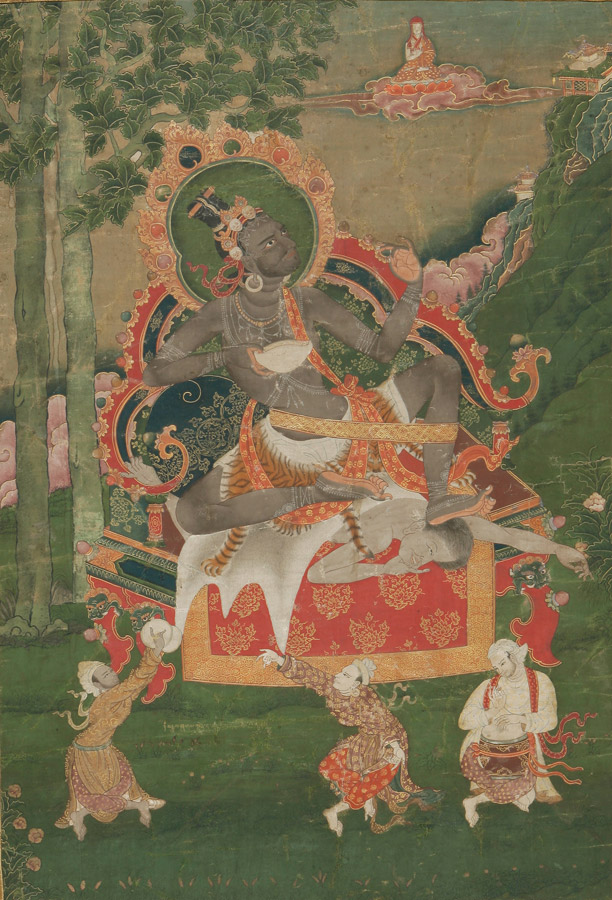Pratapaditya Pal: Roshan Sabavala’s Tryst with Himalayan Art
- click on the image to enlarge | click on the Expand icon upper left to enlarge further
click Esc to close and return to this page
Lot 67: Virupa
Distemper on cloth
Tibet, Sakya Order
Late 17th or 18th Century
28 ⅝ x 19 ½ in. (73.1 x 49.5 cm.)
Virupa is portrayed in this fine and extremely rare Sakya order thangka as a regal master surrounded by dancing musicians and seated on an elegant Chinese style yoke back throne, an indication of the reverence with which this Indian Mahasiddha is held by the Tibetan Sakyapa. In reference to his famed tantric asceticism, Virupa is shown holding a blood-filled human skull, wearing jewellery made from human bone, a tiger skin loincloth, a meditation band around his waist and lower left leg to maintain yogic posture, and seated on a flayed antelope-skin draped over a human corpse. A lama dressed in Sakya garb depicted in the clouds above the scene confirms the Sakya provenance of the thangka. Indeed Virupa is particularly revered by the Sakya order and considered the progenitor of the Margapala (Lamdre) teachings at the heart of Sakya meditational practice.
According to legend, Virupa was a 9th century follower of the teachings of the dakini Vajravarahi, living for some twenty-four years in the Eastern Indian monastery of Somapuri. His sojourn was not without controversy, and he was ejected when found eating the monastery’s pigeons against all monastic strictures. Virupa proceeded to live as a wandering ascetic performing miraculous deeds, when an episode occurred that informs the particular depiction of the Mahasiddha in this thangka. The yogin came upon a tavern and was served food and wine by the barmaid, which he greatly enjoyed and demanded more. The barmaid brought wine and asked for payment, to no avail. Instead Virupa plunged his ritual dagger in the earth and pledged to pay when the shadow of the inn reached the dagger. With his magical powers Virupa arrested the Sun’s movement across the sky, and continued drinking. Legend has it that he consumed five hundred elephant loads of spirits over two and a half days of unremitting sunshine, before the local king was persuaded by the people to settle his bill to prevent crops and livestock from perishing in the heat. Virupa finished his binge, released the Sun and disappeared. In the Sabavala thangka, the Mahasiddha is shown gazing skywards and gesturing to the Sun with his finger, expressing his magical powers and command over the Sun’s movement. For a gilt-bronze depicting this same episode, see David Weldon and Jane Casey Singer, The Sculptural Heritage of Tibet: Buddhist Art in the Nyingjei Lam Collection, London, 1999, p. 177, pl. 42. 17th and 18th century painted depictions of the Mahasiddha, such as the Sabavala Virupa, are extremely rare. A 13th century Sakya thangka depicting the same iconography is in the Kronos Collection, see Stephen M. Kossak and Jane Casey Singer, Sacred Visions: Early Paintings from Central Tibet, New York, 1998, p. 137, cat. no. 35.
